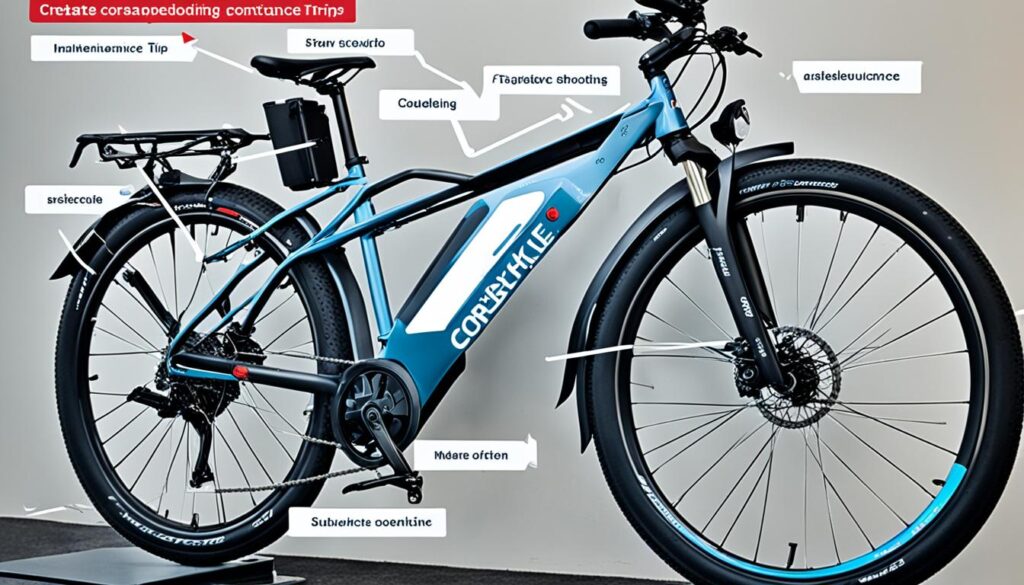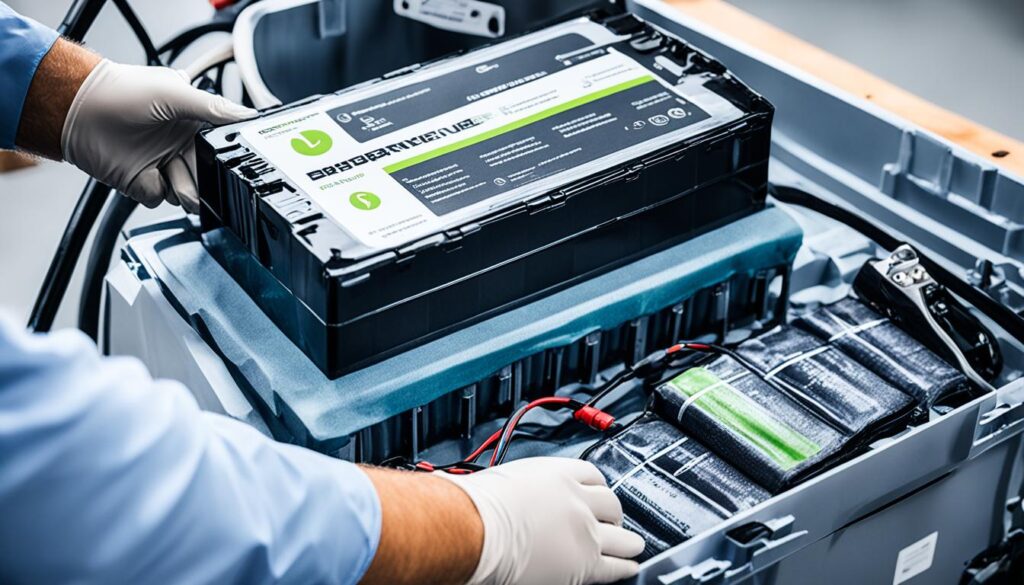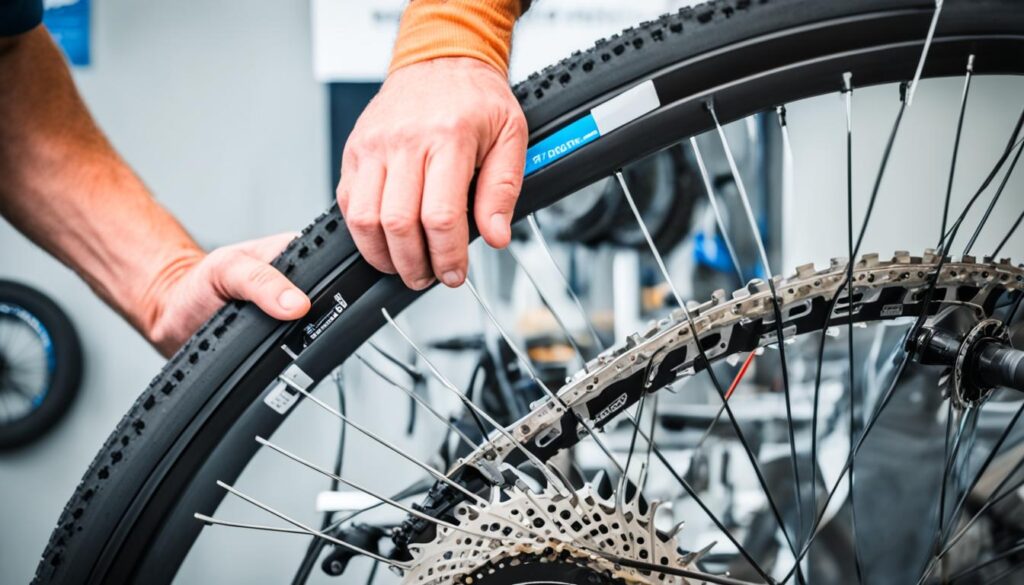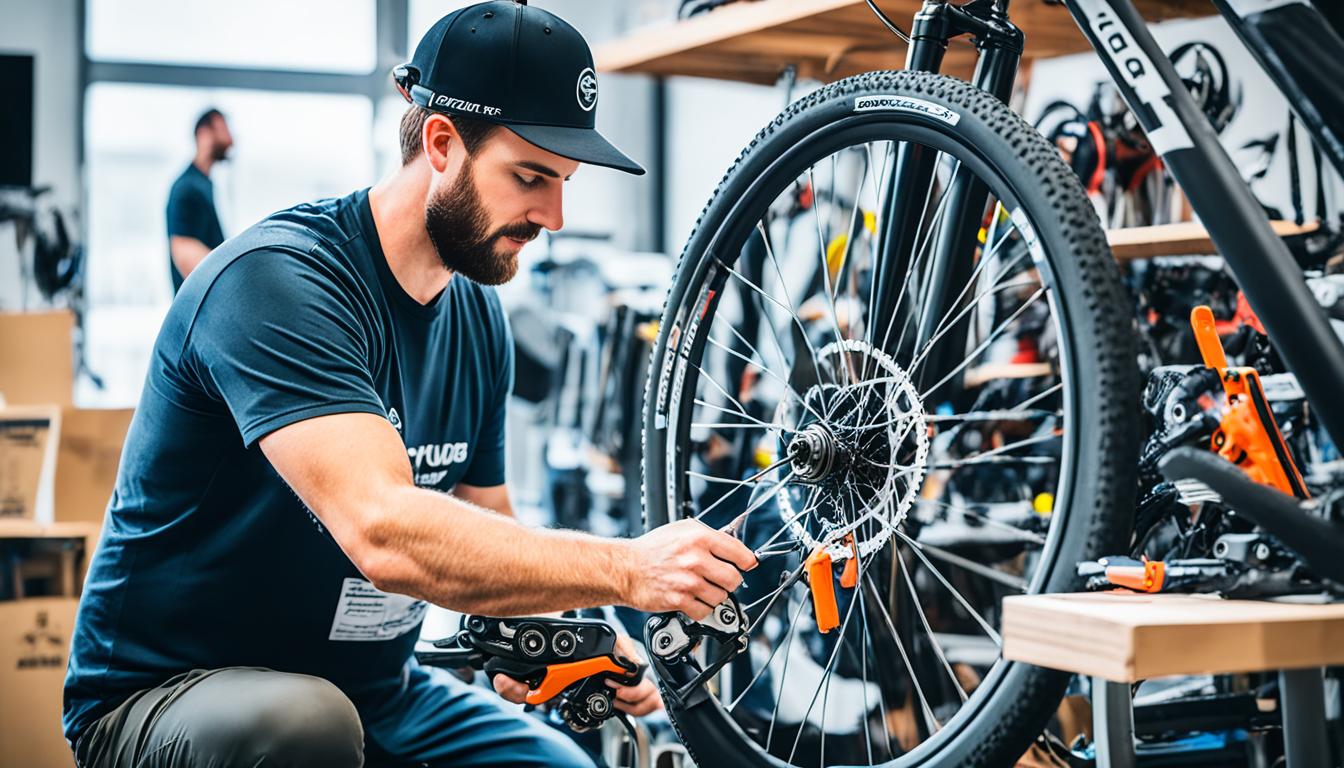Are you ready to embark on an electrifying journey with your e-bike? Before you hit the road, it’s essential to equip yourself with the knowledge of e-bike maintenance and troubleshooting. Because let’s face it – just like any other mode of transportation, e-bikes can encounter issues that need fixing. But the question is, do you know how to keep your electric steed in optimal condition?
From novice riders to seasoned enthusiasts, this comprehensive guide will empower you to tackle common e-bike problems like a pro. Whether you need DIY maintenance tips, guidance on troubleshooting technical issues, or expert advice for battery care – we’ve got you covered.
So, put on your helmet and get ready to dive into the world of e-bike maintenance and troubleshooting. With our expert tips, you’ll be back on two wheels, breezing through the streets in no time.
Key Takeaways:
- Regular maintenance is essential to keep your e-bike in optimal condition.
- Understanding common issues and troubleshooting techniques will save you time and money.
- Battery maintenance is crucial for maximizing your e-bike’s performance and lifespan.
- DIY maintenance tasks can be easily performed at home with the right knowledge and tools.
- Expert guidance is available for addressing technical issues that may arise with your e-bike.
Common E-Bike Issues and How to Fix Them

As an e-bike rider, you may encounter a few common issues that can disrupt your smooth riding experience. But fret not, because we’ve got you covered with step-by-step guidance on how to fix them. Whether you’re facing a malfunctioning motor or faulty brakes, we’ll help you troubleshoot and resolve these problems.
1. Motor Malfunction
One of the most common e-bike issues is a malfunctioning motor. If you notice that your motor is not functioning properly or has stopped working altogether, try the following troubleshooting tips:
- Check the motor connections to ensure they are secure.
- Inspect the motor wires for any damage or disconnections.
- Verify that the motor cables are properly connected to the controller.
- Ensure that the motor is receiving power by testing the battery voltage.
- If none of the above steps resolve the issue, it’s best to consult a professional e-bike mechanic or contact the manufacturer for further assistance.
2. Brake Problems
Faulty brakes can be a major safety concern. If you’re experiencing issues with your e-bike brakes, follow these troubleshooting steps:
- Check the brake pads for wear and tear. Replace them if necessary.
- Inspect the brake cables and housing for any damage or fraying. Replace them if needed.
- Adjust the brake caliper tension to ensure proper brake performance.
- If the brakes still feel spongy or fail to engage properly, bleeding the brake system may be necessary. Refer to your e-bike’s user manual or consult a professional if you’re unsure how to perform this task.
3. Electrical System Issues
The electrical system is the heart of your e-bike, and any issues can affect its overall performance. Here’s what you can do to troubleshoot common electrical system problems:
- Check all electrical connections to ensure they are tightly secured.
- Inspect the wiring harness for any signs of damage or loose connections.
- Ensure that the battery is fully charged and properly installed.
- Test the throttle and display unit for any malfunctions. If necessary, replace them with compatible parts.
- If the issue persists, consult a professional e-bike technician for further diagnosis and repair.
Remember, these are just some of the common e-bike issues you may encounter. If you’re facing a problem that is not covered here, don’t hesitate to seek professional assistance. It’s always better to ensure your e-bike is in optimal condition for a safer and more enjoyable ride.
E-Bike Battery Maintenance and Care

When it comes to e-bike performance, the battery is the powerhouse that keeps you going. Just like any other piece of technology, proper maintenance is key to ensuring optimal performance and a longer lifespan for your e-bike battery.
“The battery is the heart of your e-bike. Treat it right, and it will keep you rolling for miles on end.”
Tips for Extending Battery Lifespan
Here are some handy tips to help you get the most out of your e-bike battery:
- Charge it Right: Always use the charger provided by the manufacturer and avoid using fast chargers that could potentially harm the battery. Remember to connect the charger to a stable power source and avoid charging in extreme temperatures.
- Avoid Full Discharge: While lithium-ion batteries don’t have a memory effect like older battery technologies, it’s still best to avoid completely draining the battery. Try to recharge it when it reaches around 20-30% capacity.
- Store it Smartly: If you’re storing your e-bike for an extended period, make sure to charge the battery to around 50% capacity and store it in a cool, dry place. Avoid exposing the battery to extreme temperatures, as this can degrade its performance.
- Regularly Inspect for Damage: Keep a close eye on your battery for any signs of physical damage or wear. If you notice any cracks or leaks, it’s best to replace the battery rather than risk further damage or reduced performance.
Caring for Your E-Bike Battery
In addition to the tips mentioned above, here are a few more care practices that can help maintain your e-bike battery:
- Proper Cleaning: Keeping your battery clean and free from dirt or debris can prevent damage and improve performance. Use a soft cloth or sponge to gently wipe away any dirt.
- Keep Battery Cool: Avoid exposing your e-bike to direct sunlight for extended periods, as excessive heat can harm the battery. If possible, park your e-bike in a shaded area or use a cover.
- Follow Manufacturer Guidelines: Always refer to the manufacturer’s guidelines for specific recommendations on e-bike battery care and maintenance. Each battery may have unique requirements that are essential for optimal performance.
By following these e-bike battery maintenance tips, you can ensure that your battery performs at its best and provides you with a reliable and enjoyable riding experience for years to come.
Essential DIY E-Bike Maintenance Tasks
Keeping your e-bike in top shape requires regular maintenance. By performing essential DIY tasks at home, you can ensure that your e-bike runs smoothly and reliably. Here are some key tasks that every e-bike owner should know:
Tire Pressure Checks
Maintaining the correct tire pressure is crucial for optimal performance and safety. Use a tire pressure gauge to regularly check the pressure of your e-bike tires. Inflate or deflate them as needed to maintain the recommended pressure range, which is usually indicated on the tire sidewall.
Chain Lubrication
A well-lubricated chain is essential for smooth and efficient pedaling. Apply a high-quality bicycle chain lubricant to your e-bike chain regularly. Make sure to wipe off any excess oil to prevent dirt and debris from sticking to the chain.
Brake Inspections
Properly functioning brakes are crucial for your safety on the road. Regularly inspect your e-bike’s brake pads for wear and tear. Replace them if they are worn down beyond the recommended thickness. Additionally, ensure that the brake cables are properly tensioned and adjusted.
Battery Maintenance
While we discuss battery maintenance in more detail in Section 3, it’s important to mention its significance here as well. Regularly check the battery connections to ensure they are secure and free from corrosion. Clean the terminals if necessary. Additionally, make sure to follow the manufacturer’s guidelines for charging and storing your e-bike battery properly.
Suspension Inspection
If your e-bike has a suspension system, it’s essential to regularly inspect it for any signs of damage or wear. Check for any oil leaks, loose bolts, or broken parts. If you notice any issues, take your e-bike to a professional for servicing or follow the manufacturer’s instructions for DIY repairs.
“Regular maintenance is like giving your e-bike a spa day. It keeps it happy and running smoothly.” – Cycling enthusiast
By incorporating these essential DIY maintenance tasks into your routine, you can ensure that your e-bike remains in top condition. Remember, a well-maintained e-bike not only provides a more enjoyable riding experience but also ensures your safety on the road. Stay tuned for more e-bike maintenance tips and tricks in the upcoming sections!
Troubleshooting E-Bike Technical Issues

When it comes to e-bikes, technical issues can sometimes arise, causing frustration and inconvenience. But fear not! In this section, we will provide you with a comprehensive guide to troubleshooting and resolving common technical problems on your electric bike.
1. Motor Malfunctions
One of the most common technical issues e-bike riders encounter is motor malfunctions. If you experience a sudden loss of power or unusual noises coming from the motor, it’s time to dig deeper. Start by checking the motor connections and ensuring they are secure. If everything looks good, try resetting the motor controller. If the problem persists, it might be necessary to replace the motor or seek professional assistance.
2. Electrical System Problems
The electrical system of your e-bike is responsible for controlling various functions and features. If you encounter issues such as flickering lights, a non-responsive display, or erratic behavior of the electronic components, it’s crucial to address them promptly. Check the battery connections and ensure they are secure. Inspect the wiring for any signs of damage or loose connections. If necessary, consult the e-bike’s user manual or contact the manufacturer for specialized support.
3. Battery Troubles
The e-bike battery is the lifeblood of your electric ride, and proper maintenance is essential for longevity and optimal performance. If you’re faced with a battery that isn’t holding a charge or doesn’t provide the expected range, there are a few steps you can take to troubleshoot the issue. Start by checking the battery connections and cleaning any corrosion. Ensure the battery is charged correctly and consider calibrating it if needed. If the problem persists, it may be necessary to replace the battery or seek professional assistance.
4. Display and Control Panel Issues
If you’re experiencing difficulties with the display or control panel of your e-bike, it can be frustrating, as it affects your ability to access important information and adjust settings. Start by checking the connections between the display panel and the main controller. Ensure they are secure and free from damage. If the problem persists, consult the user manual for troubleshooting tips or contact the manufacturer for further assistance.
“Troubleshooting technical issues on your e-bike doesn’t have to be a daunting task. By following our step-by-step guide and being patient and thorough in your investigations, you’ll soon have your e-bike back in top shape!”
Conclusion
With our expert tips and guidance, you’ll be able to enhance your e-bike maintenance and troubleshooting skills effortlessly. By diligently following these recommendations, and performing regular maintenance tasks, you can ensure a seamless and enjoyable ride on your e-bike for years to come.
Remember to prioritize proper battery maintenance and care to get the most out of your e-bike’s performance. Additionally, stay vigilant and address common issues promptly using our step-by-step guides. Taking preventive measures and promptly addressing technical problems will significantly prolong the lifespan of your e-bike.
Utilizing our DIY maintenance tasks, you can easily keep your e-bike in prime condition. From tire pressure checks to chain lubrication, these simple tasks will help optimize your e-bike’s performance and save you money on repairs.
Whether it’s troubleshooting technical issues or performing routine maintenance, our comprehensive guide will equip you with the necessary knowledge to confidently handle any e-bike-related challenges that may arise. Enjoy a hassle-free riding experience and unlock the full potential of your e-bike by implementing our tips and maintaining your e-bike regularly.
